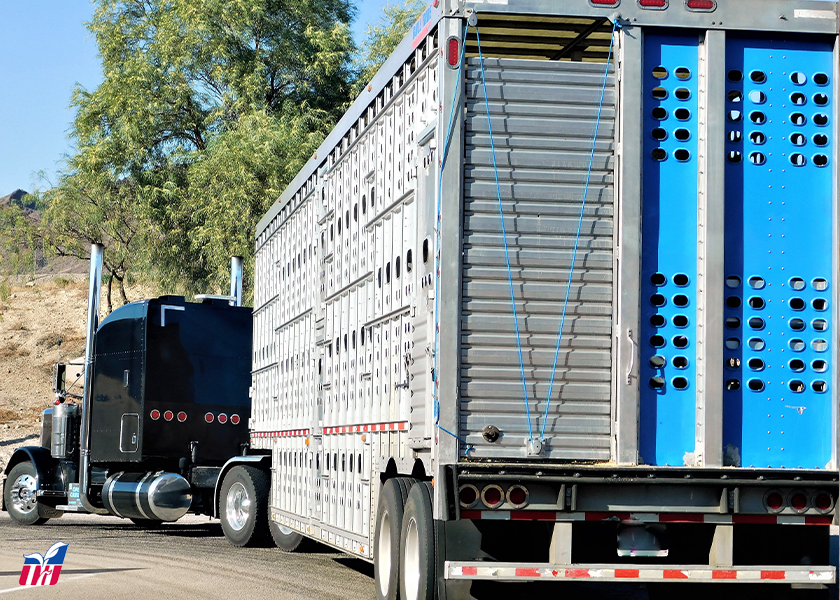Livestock Analysis | April 12, 2024

Price action: Outside markets seemed to sink hog futures Friday. The April contract expired at noon, having dipped 57.5 cents to settle at $90.875. Most-active June futures plunged $3.725 to $102.075. The closing quote marked a weekly drop of $5.825.
5-day outlook: Expect renewed downward pressure on hog futures early next week, since today’s breakdown, which followed a similar dive on Wednesday, has given bears considerable downward momentum to work with. However, fundamentals remain quite supportive. As expected, Wednesday’s official quote for the hog index was stated at $89.84, up $1.06 from Tuesday. Thursday’s preliminary figure rose another 72 cents to $90.56. Traders apparently doubted the cash market will sustain its recent advance today, since the April contract (which will cash-settle against today’s official quote next Tuesday) closed just 31.5 cents above the cash-equivalent price. Pork prices remain elevated, with sizeable ham and rib losses more than offsetting big pork butt gains today; cutout slipped 71 cents at noon after reaching $101.29 Thursday afternoon. Nevertheless, futures fell dramatically, which we are inclined to blame on concurrent fed cattle losses, along with big declines in the equity indexes and strong U.S. dollar gains. Those developments could hurt demand from domestic consumer and export customers, respectively.
30-day outlook: Bears may be anticipating significant year-to-year increases in hog slaughter in the next few weeks. They were probably persuaded by the idea that this week’s total would follow last week’s sizeable annual increase and easily top the year-ago total. That was indeed the case, with the weekly total of 2.485 million head topping the year-ago figure by 58,000 or 2.4%. The March USDA Hogs & Pigs report implied hog numbers essentially matching those seen last April, but the industry has been trained to expect annual increases over the past 15 months. We are more optimistic about the price outlook, due largely to ideas the demand strength seen through the first quarter will persist into early summer.
90-day outlook: As is often the case, the big question facing the hog and pork industry is whether the cash market will eventually justify the large premiums built into the May-August hog contracts. Seasonal reductions in hog supplies through the second quarter play a big role in the usual seasonal price surge, with robust grilling demand also helping power the rally. As noted above, we expect consumer demand to remain quite strong, especially after grocers again held the line on retail pork prices through March. We also believe relatively low pork belly stockpiles improve the price outlook for wholesale bacon as BLT season looms, which in turn should translate into hog market strength.
What to do: Get current with feed advice. Carry all production risk in the cash market for now.
Hedgers: Carry all risk in the cash market for now.
Feed needs: You should have all corn-for-feed and soymeal needs covered in the cash market another month through April.
Price action: Weak cash prices and slumping equity indexes seemed to sink cattle futures Friday. Nearby April fed cattle fell $1.35 to $178.90, while most-active June sank $2.425 to $171.475. That latter close marked a weekly drop of 57.5 cents. May feeder futures plunged $3.95 to $234.20, which left the contract $3.975 below last Friday’s close.
5-day outlook: The latest cattle and beef news was not particularly bearish. For example, the USDA reported active Thursday cash trading in this morning’s report, with the five-area average for steer prices falling about $1.90 from last week’s mean, to $183.88. That was widely expected. In fact, numerous traders were probably expecting a larger weekly decline. Moreover, choice- and select-grade beef values bounced $2.07 and $1.13, respectively, at noon today, with the former pushing back above the $300.00 level. But today’s sizeable equity market losses and another surge in the value of the U.S. dollar were likely viewed as discouraging domestic and export demand for U.S. beef, which seemed to spur across-the-board selling. Feeder futures were no exception either. Next week’s price prospects declined in turn.
30-day outlook: The latest “final” weekly slaughter report stated average steer dressed weights at 923 pounds per head, down just one pound from the previous week’s surprisingly high reading. And while the choice-select spread widened somewhat today, both factors still point to plentiful supplies of well-finished fed cattle in U.S. feedlots. This week’s cattle slaughter of 603,00 head fell 8,000-10,000 head short of comparable week- and year-ago levels, implying no improvement in packer demand. That indicates little chance of improvement in price prospects for the near future. As long as the packing industry maintains recent operational cutbacks, the cattle market is unlikely to sustain cash or futures advances.
90-day outlook: The preceding discussion also holds for the 90-day outlook. We suspect packers will accelerate their processing activities, but only after their margins move back into the black. Those are currently well into the red, with the latest industry estimate coming in over $100.00 underwater today. Things could certainly improve if consumer demand remains robust if/when grocers once again start boosting retail prices. They have been surprisingly successful in holding the line on wholesale beef prices lately, but those probably have to improve if packer margins are to turn profitable in the near future. Unfortunately, we don’t see the cattle/beef situation improving substantially before late summer.
What to do: Get current with feed advice. All production risk in the cash market for now but be prepared for some hedge coverage as we have demand concerns.
Hedgers: Carry all risk in the cash market for now.
Feed needs: You should have all corn-for-feed and soymeal needs covered in the cash market another month through April.






